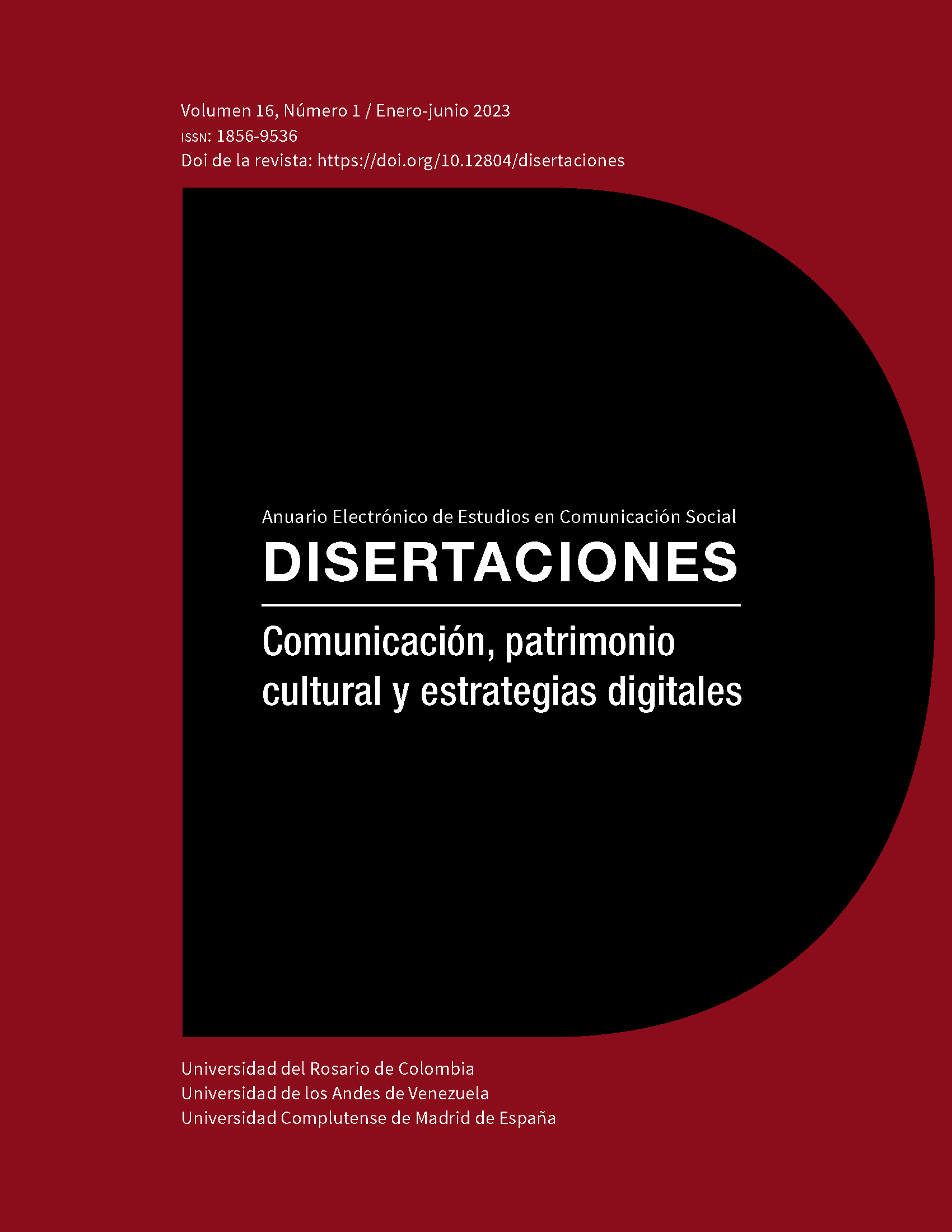Limitaciones de la realidad aumentada en el sector turístico
Barra lateral del artículo
Contenido principal del artículo
El desarrollo de la tecnología y la irrupción de las aplicaciones de Realidad Aumentada (ra) han transformado el proceso experiencial en el turismo. Se ha demostrado el gran potencial y las ventajas que esta ofrece al sector, especialmente tras la covid-19. El objetivo de este estudio es averiguar y profundizar en el conocimiento de las posibles limitaciones que aún presentan las aplicaciones de ra. Esta investigación analizó una plataforma de RA, Imageen Tarraco (Tarragona, España) a partir de una encuesta a usuarios, entrevistas a profundidad y un grupo focal. El análisis mostró el desconocimiento y los problemas técnicos como las grandes limitaciones de la aplicación. Categorizó las limitaciones por tipo de público, profundizó en los factores que favorecen o no su uso y las principales causas de estas limitaciones. El estudio proporciona recomendaciones útiles tanto para los creadores de plataformas de RA como para las organizaciones de gestión de destino (ogd) que las implementan.
Descargas
Ayeh, J., Au, N., & Law, R. (2013). Towards an understanding of online travellers’ acceptance of consumergenerated media for travel planning: Integrating technology acceptance and source credibility factors. In L. Cantoni & Z. Xiang (Eds.), Information and communication technologies in tourism 2013 (pp. 254-267). Springer. https://doi.org/10.1007/978-3-642-36309-2_22
Buhalis, D., & Amaranggana, A. (2015). Smart tourism destinations enhacing tourism experience through personalisation of services. In I. Tussydiah & A. Inversini (Eds.), Information and Communication Technologies in Tourism 2015 (pp. 377-389). Springer. https://doi.org/10.1007/978-3-319-14343-9_28
Burdea, G. C., & Coiffet, P. (2003). Virtual reality technology (2nd ed.). Hoboken, NJ: Wiley-Interscience
Chung, N., Han, H., & Joun, Y. (2015). Tourists’ intention to visit a destination: The role of augmented reality (ar) application for a heritage site. Computers in Human Behavior, 50, 588-599. https://doi.org/10.1016/j.chb.2015.02.068
Chung, N., Lee, H., Kim, J. Y., & Koo, C. (2018). The role of augmented reality for experience-influenced environments: The case of cultural heritage tourism in Korea. Journal of Travel Research, 57(5), 627-643. https://doi.org/10.1177/0047287517708255
Chung, N., Lee, H., Lee, S. J., & Koo, C. (2015). The influence of tourism website on tourists’ behavior to determine destination selection: A case study of creative economy in Korea. Technological Forecasting and Social Change, 96, 130-143. https://doi.org/https://doi.org/10.1016/j.techfore.2015.03.004
Cranmer, E., Jung, T., tom Dieck, M. C., & Miller, A. (2016). Understanding the acceptance of augmented reality at an organisational level: The case of Geevor Tin Mine Museum. In A. Inversini & R. Schegg (Eds.), Information and Communication Technologies in Tourism 2016 (pp. 637-650). Springer. https://doi.org/10.1007/978-3-319-28231-2_46
Cranmer, E. E., tom Dieck, M. C., & Jung, T. (2018). How can tourist attractions profit from augmented reality? In T. Jung & M. tom Dieck (Eds.), Augmented reality and virtual reality (pp. 21-32). Springer. https://doi.org/10.1007/978-3-319-64027-3_2
Cranmer, E. E., tom Dieck, M. C., & Fountoulaki, P. (2020). Exploring the value of augmented reality for tourism. Tourism Management Perspectives, 35, 100672. https://doi.org/10.1016/j.tmp.2020.100672
Cranmer, E. E., Urquhart, C., Claudia tom Dieck, M., & Jung, T. (2021). Developing augmented reality business models for smes in tourism. Information and Management, 58(8), 103551. https://doi.org/10.1016/j.im.2021.103551
Davis, F. D. (1986). A technology acceptance model for empirically testing new end-user information systems. (Doctoral dissertation, Massachusetts Institute of Technology, Cambridge, MA, United States of America). http://hdl.handle.net/1721.1/15192
tom Dieck, M. C., Jung, T., & Han, D.-I. (2016). Mapping requirements for the wearable smart glasses augmented reality museum application. Journal of Hospitality and Tourism Technology, 7(3), 230-253. https://doi.org/10.1108/JHTT-09-2015-0036
tom Dieck, M. C., Jung, T. H., & tom Dieck, D. (2018). Enhancing art gallery visitors’ learning experience using wearable augmented reality: Generic learning outcomes perspective. Current Issues in Tourism, 21(17), 2014-2034. https://doi.org/10.1080/13683500.2016.1224818
tom Dieck, M. C., & Jung, T. (2018). A theoretical model of mobile augmented reality acceptance in urban heritage tourism. Current Issues in Tourism, 21(2), 154-174. https://doi.org/10.1080/13683500.2015.1070801
tom Dieck, M. C., & Jung, T. H. (2017). Value of augmented reality at cultural heritage sites: A stakeholder approach. Journal of Destination Marketing and Management, 6(2), 110-117. https://doi.org/10.1016/j.jdmm.2017.03.002
Dueholm, J., & Smed, K. M. (2014). Heritage authenticities —A case study of authenticity perceptions at a Danish heritage site. Journal of Heritage Tourism, 9(4), 285-298. https://doi.org/10.1080/1743873X.2014.905582
Guerra, J. P., Pinto, M. M., & Beato, C. (2015). Virtual reality-shows a new vision for tourism and heritage. European Scientific Journal (esj), 11(9). https://doi.org/10.19044/esj.2015.v11n9p%25p
Guttentag, D. (2010). Virtual reality: Applications and implications for tourism. Tourism Management, 31(5), 637-651. https://doi.org/10.1016/j.tourman.2009.07.003
Han, D. I., tom Dieck, M. C., & Jung, T. (2018). User experience model for augmented reality applications in urban heritage tourism. Journal of Heritage Tourism, 13(1), 46-61. https://doi.org/10.1080/1743873X.2016.1251931
Haugstvedt, A. C., & Krogstie, J. (2012). Mobile augmented reality for cultural heritage: A technology acceptance study. 2012 ieee International Symposium on Mixed and Augmented Reality (ismar), 247-255. ieee. https://doi.org/10.1109/ISMAR.2012.6402563
Huang, Y.-C., Backman, S. J., Backman, K. F., & Moore, D. (2013). Exploring user acceptance of 3D virtual worlds in travel and tourism marketing. Tourism Management, 36, 490-501. https://doi.org/10.1016/j.tourman.2012.09.009
Huang, Y. C., Backman, K. F., Backman, S. J., & Chang, L. L. (2016). Exploring the implications of virtual reality technology in tourism marketing: An integrated research framework. International Journal of Tourism Research, 18(2), 116-128. https://doi.org/10.1002/jtr.2038
Huang, Y. C., Backman, S. J., & Backman, K. F. (2012). Exploring the impacts of involvement and flow experiences in Second Life on people’s travel intentions. Journal of Hospitality and Tourism Technology, 3(1), 4-23. https://doi.org/10.1108/17579881211206507
Huertas, A., & Gonzalo, J. (2020). The role of augmented reality in destination branding. Tourism and Hospitality Management, 26(2), 419-436. https://doi.org/10.20867/THM.26.2.8
Hyun, M. Y., & O’Keefe, R. M. (2012). Virtual destination image: Testing a telepresence model. Journal of Business Research, 65(1), 29-35. https://doi.org/10.1016/j.jbusres.2011.07.011
Jiang, S., Moyle, B., Yung, R., Tao, L., & Scott, N. (2022). Augmented reality and the enhancement of memorable tourism experiences at heritage sites. Current Issues in Tourism, 1-16. https://doi.org/10.1080/13683500.2022.2026303
Jingen Liang, L., & Elliot, S. (2021). A systematic review of augmented reality tourism research: What is now and what is next? Tourism and Hospitality Research, 21(1), 15-30. https://doi.org/10.1177/1467358420941913
Jung, T. H., & tom Dieck, M. C. (2017). Augmented reality, virtual reality and 3D printing for the co-creation of value for the visitor experience at cultural heritage places. Journal of Place Management and Development, 10(2), 140-151. https://doi.org/10.1108/JPMD-07-2016-0045
Jung, T., Chung, N., & Leue, M. C. (2015). The determinants of recommendations to use augmented reality technologies: The case of a Korean theme park. Tourism Management, 49, 75-86. https://doi.org/10.1016/j.tourman.2015.02.013
Kalantari, M., & Rauschnabel, P. (2018). Exploring the early adopters of augmented reality smart glasses: The case of Microsoft HoloLens. In T. Jung & M. tom Dieck (Eds.), Augmented reality and virtual reality (pp. 229-245). Springer. https://doi.org/10.1007/978-3-319-64027-3_16
Kounavis, C. D., Kasimati, A. E., & Zamani, E. D. (2012). Enhancing the tourism experience through mobile augmented reality: Challenges and prospects. International Journal of Engineering Business Management, 4(Special Issue Digital and Mobile Economy), 1-6. https://doi.org/10.5772/51644
Lee, H., Chung, N., & Jung, T. (2015). Examining the cultural differences in acceptance of mobile augmented reality: Comparison of South Korea and Ireland. In I. Tussyadiah & A. Inversini (Eds.), Information and communication technologies in tourism 2015 (pp. 477-491). Springer. https://doi.org/10.1007/978-3-319-14343-9_35
Lee, S., Park, D. H., & Han, I. (2014). New members’ online socialization in online communities: The effects of content quality and feedback on new members’ content-sharing intentions. Computers in Human Behavior, 30, 344-354. https://doi.org/10.1016/j.chb.2013.09.015
Leue, M. C., Jung, T., & tom Dieck, D. (2015). Google glass augmented reality: Generic learning outcomes for art galleries. In I. Tussyadiah & A. Inversini (Eds.), Information and communication technologies in tourism 2015 (pp. 463-476). Springer. https://doi.org/10.1007/978-3-319-14343-9_34
Leue, M.C., tom Dieck, D., & Jung, T. (2014). A theoretical model of augmented reality acceptance. EReview of Tourism Research, 5, 1-5. https://e-space.mmu.ac.uk/id/eprint/608490
Lin, C. H., Shih, H. Y., & Sher, P. J. (2007). Integrating technology readiness into technology acceptance: The tram model. Psychology & Marketing, 24(7), 641-657. https://doi.org/10.1002/mar.20177
Lin, J. S. C., & Chang, H. C. (2011). The role of technology readiness in self-service technology acceptance. Managing Service Quality: An International Journal, 21(4), 424-444. https://doi.org/10.1108/09604521111146289
Lin, J. S. C., & Hsieh, P. L. (2007). The influence of technology readiness on satisfaction and behavioral intentions toward self-service technologies. Computers in Human Behavior, 23(3), 1597-1615. https://doi.org/10.1016/j.chb.2005.07.006
Marasco, A., Buonincontri, P., van Niekerk, M., Orlowski, M., & Okumus, F. (2018). Exploring the role of next-generation virtual technologies in destination marketing. Journal of Destination Marketing and Management, 9, 138-148. https://doi.org/10.1016/j.jdmm.2017.12.002
Mascho, E., & Singh, N. (2014). Virtual tourism: Use of “Second Life” for destination marketing. Anatolia, 25(1), 140-143. https://doi.org/10.1080/13032917.2013.815644
Mohanty, P., Hassan, A., & Ekis, E. (2020). Augmented reality for relaunching tourism post-covid-19: Socially distant, virtually connected. Worldwide Hospitality and Tourism Themes, 12(6), 753-760. https://doi.org/10.1108/WHATT-07-2020-0073
Neuhofer, B., Buhalis, D., & Ladkin, A. (2014). A typology of technology‐enhanced tourism experiences. International Journal of Tourism Research, 16(4), 340-350. https://doi.org/10.1002/jtr.1958
Oh, J. C., Yoon, S. J., & Chung, N. (2014). The role of technology readiness in consumers’ adoption of mobile internet services between South Korea and China. International Journal of Mobile Communications, 12(3), 229-248. https://doi.org/10.1504/IJMC.2014.061460
Olsson, T., Kärkäinen, T., Lagerstam, E., & Ventä-Olkkonen, L. (2012). User evaluation of mobile augmented reality scenarios. Journal of Ambient Intelligence and Smart Environments, 4(1), 29-47. https://doi.org/10.3233/AIS-2011-0127
Oyman, M., Bal, D., & Ozer, S. (2022). Extending the technology acceptance model to explain how perceived augmented reality affects consumers’ perceptions. Computers in Human Behavior, 128, 107127. https://doi.org/10.1016/j.chb.2021.107127
Parasuraman, A. (2000). Technology Readiness Index (tri) a multiple-item scale to measure readiness to embrace new technologies. Journal of Service Research, 2(4), 307-320. https://doi.org/10.1177/109467050024001
Prayag, G., Hosany, S., & Odeh, K. (2013). The role of tourists’ emotional experiences and satisfaction in understanding behavioral intentions. Journal of Destination Marketing & Management, 2(2), 118-127. https://doi.org/10.1016/j.jdmm.2013.05.001
Rasimah, C. M. Y., Ibrahim, R., Zaman, H., Ahmad, A., & Suhaifi, S. (2011). Users acceptance of mixed reality technology. Issues in Information Systems, 12(1), 194-205. https://doi.org/10.48009/1_iis_2011_194-205
Rauschnabel, P. A., Babin, B. J., tom Dieck, M. C., Krey, N., & Jung, T. (2022). What is augmented reality marketing? Its definition, complexity, and future. Journal of Business Research, 142, 1140-1150. https://doi.org/10.1016/j.jbusres.2021.12.084
Tsai, S.-pei. (2020). Augmented reality enhancing place satisfaction for heritage tourism marketing. Current Issues in Tourism, 23(9), 1078-1083. https://doi.org/10.1080/13683500.2019.1598950
Tscheu, F., & Buhalis, D. (2016). Augmented reality at cultural heritage sites. In A. Inversini & R. Schegg (Eds.), Information and communication technologies in tourism 2016 (pp. 607-619). Springer. https://doi.org/10.1007/978-3-319-28231-2_44
Tussyadiah, I. P., Wang, D., Jung, T. H., & tom Dieck, M. C. (2018). Virtual reality, presence, and attitude change: Empirical evidence from tourism. Tourism Management, 66, 140-154. https://doi.org/10.1016/j.tourman.2017.12.003
van Nuenen, T., & Scarles, C. (2021). Advancements in technology and digital media in tourism. Tourist Studies, 21(1), 119-132. https://doi.org/10.1177/1468797621990410
Wu, K., Zhao, Y., Zhu, Q., Tan, X., & Zheng, H. (2011). A meta-analysis of the impact of trust on technology acceptance model: Investigation of moderating influence of subject and context type. International Journal of Information Management, 31(6), 572-581. https://doi.org/10.1016/j.ijinfomgt.2011.03.004
Wu, X., & Lai, I. K. W. (2021). The acceptance of augmented reality tour app for promoting film-induced tourism: the effect of celebrity involvement and personal innovativeness. Journal of Hospitality and Tourism Technology, 12(3), 454-470. https://doi.org/10.1108/JHTT-03-2020-0054
Yovcheva, Z., Buhalis, D., & Gatzidis, C. (2013). Engineering augmented tourism experiences. In L. Cantoni & Z. Xiang (Eds.), Information and Communication Technologies in Tourism 2013 (pp. 24-35). Springer. https://doi.org/10.1007/978-3-642-36309-2_3
Yovcheva, Z., Buhalis, D., & Gatzidis, C. (2012). Smartphone augmented reality applications for tourism. EReview os Tourism Research (ertr), 10(2), 63-66. http://eprints.bournemouth.ac.uk/20219/1/eRTR_SI_V10i2_Yovcheva_Buhalis_Gatzidis_63-66.pdf
Yung, R., & Khoo-Lattimore, C. (2019). New realities: a systematic literature review on virtual reality and augmented reality in tourism research. Current Issues in Tourism, 22(17), 2056-2081. https://doi.org/10.1080/13683500.2017.1417359
Zarmipou, T., Saprikis, V., Markos, A., & Vlachopolou, M. (2012). Modeling users’ acceptance of mobile services. Electronic Commerce Research, 12, 225-248. https://doi.org/10.1007/s10660-012-9092-x
Detalles del artículo

Esta obra está bajo una licencia internacional Creative Commons Atribución-NoComercial-SinDerivadas 4.0.



